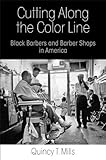Cutting Along the Color Line : Black Barbers and Barber Shops in America / Quincy T. Mills.
Material type: TextPublisher: Philadelphia : University of Pennsylvania Press, [2013]Copyright date: ©2014Description: 1 online resource (336 p.) : 19 illusContent type:
TextPublisher: Philadelphia : University of Pennsylvania Press, [2013]Copyright date: ©2014Description: 1 online resource (336 p.) : 19 illusContent type: - 9780812245417
- 9780812208658
- African American barbers -- History -- 19th century
- African American barbers -- History -- 20th century
- Barbershops -- United States -- History -- 19th century
- Barbershops -- United States -- History -- 20th century
- American Studies
- HISTORY / United States / 20th Century
- African Studies
- African-American Studies
- American History
- American Studies
- 646.72408996073
- HD8039.B32 -- U647 2013eb
- online - DeGruyter
- Issued also in print.
| Item type | Current library | Call number | URL | Status | Notes | Barcode | |
|---|---|---|---|---|---|---|---|
 eBook
eBook
|
Biblioteca "Angelicum" Pont. Univ. S.Tommaso d'Aquino Nuvola online | online - DeGruyter (Browse shelf(Opens below)) | Online access | Not for loan (Accesso limitato) | Accesso per gli utenti autorizzati / Access for authorized users | (dgr)9780812208658 |
Frontmatter -- Contents -- Preface -- Introduction -- Part I. Barbering in Slavery and Freedom -- Chapter 1. Barbering for Freedom in Antebellum America -- Chapter 2. The Politics of "Color-Line" Barber Shops After the Civil War -- Chapter 3. Race, Regulation, and the Modern Barber Shop -- Part II. Black Barbers, Patrons, and Public Spaces -- Chapter 4. Rise of the New Negro Barber -- Chapter 5. Bigger Than a Haircut Desegregation and the Barber Shop -- Chapter 6. The Culture and Economy of Modern Black Barber Shops -- Epilogue -- Notes -- Index -- Acknowledgments
restricted access online access with authorization star
http://purl.org/coar/access_right/c_16ec
Today, black-owned barber shops play a central role in African American public life. The intimacy of commercial grooming encourages both confidentiality and camaraderie, which make the barber shop an important gathering place for African American men to talk freely. But for many years preceding and even after the Civil War, black barbers endured a measure of social stigma for perpetuating inequality: though the profession offered economic mobility to black entrepreneurs, black barbers were obliged by custom to serve an exclusively white clientele. Quincy T. Mills traces the lineage from these nineteenth-century barbers to the bustling enterprises of today, demonstrating that the livelihood offered by the service economy was crucial to the development of a black commercial sphere and the barber shop as a democratic social space.Cutting Along the Color Line chronicles the cultural history of black barber shops as businesses and civic institutions. Through several generations of barbers, Mills examines the transition from slavery to freedom in the nineteenth century, the early twentieth-century expansion of black consumerism, and the challenges of professionalization, licensing laws, and competition from white barbers. He finds that the profession played a significant though complicated role in twentieth-century racial politics: while the services of shaving and grooming were instrumental in the creation of socially acceptable black masculinity, barbering permitted the financial independence to maintain public spaces that fostered civil rights politics. This sweeping, engaging history of an iconic cultural establishment shows that black entrepreneurship was intimately linked to the struggle for equality.
Issued also in print.
Mode of access: Internet via World Wide Web.
In English.
Description based on online resource; title from PDF title page (publisher's Web site, viewed 30. Aug 2021)


